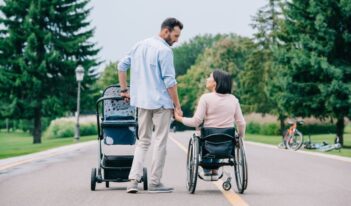
COVID-19 has triggered discussions around the discriminatory impacts of crisis standards of care in medicine.
During the COVID-19 pandemic, Michael Hickson’s story has become an example of what many people with disabilities consider their worst nightmare.
Mr. Hickson, a 46-year-old Black man with quadriplegia, contracted COVID-19 and died after his doctors transferred him from the ICU to hospice care.
Before Mr. Hickson’s death, his wife apparently recorded a conversation with one of his physicians, in which the doctor explains why the hospital is going to stop treatment.
In the recording, as it has been reported in the media, the doctor seems to explain his view that continued treatment would be “futile” because Mr. Hickson does not have much of a “quality of life.” When Mr. Hickson’s wife asks the doctor to clarify his statement and whether he means Mr. Hickson does not have quality of life “because he is paralyzed with a brain injury,” the doctor responds “correct.”
When Mr. Hickson’s wife continues to question the doctor about treatments provided to other COVID-19 patients who recovered, the doctor explains that other patients were younger, had fewer health conditions, and were “walking, talking people” with a different “quality of life.” Near the end of the recording, the doctor tells Mr. Hickson’s wife that the decision to stop treating her husband is one between the “medical community and the state.”
Mr. Hickson acquired quadriplegia after going into cardiac arrest while driving his wife to work three years earlier. At the time of Mr. Hickson’s final hospitalization in 2020, a Texas probate court had allegedly appointed a state guardianship program as his temporary guardian while awaiting the resolution of a legal dispute about the appointment of a permanent guardian for him.
There is now an ongoing lawsuit about the circumstances of Mr. Hickson’s death. The basic facts of the controversy as reported publicly, however, exemplify the seriousness of the disability community’s concerns about the consequences of stereotypes that many people—including medical professionals—often believe about what it is like to live with a disability and the subsequent value of disabled lives.
Throughout the COVID-19 pandemic, people with disabilities have grappled with messages about their increased vulnerability and apparent expendability, especially in situations where medical equipment and resources are limited. The U.S. Department of Health and Human Services (HHS) even issued a bulletin reminding covered entities of their obligations under civil rights laws not to discriminate in the provision of health care services based on race, national origin, sex, age, or disability.
Nevertheless, disability advocacy groups around the country have filed administrative complaints with the Office of Civil Rights (OCR) at HHS challenging disability discrimination in health care during the pandemic.
In addition to a complaint requesting an investigation into the death of Michael Hickson, disability rights organizations have also filed other complaints that call for the modification of crisis standards of care–the plans or guidelines that medical professionals use to determine who gets treatment when resources are scarce.
Some crisis standards of care plans initially included language prohibiting people with certain disabilities or medical conditions from being offered potentially life-sustaining ventilation support. Other plans placed people with disabilities at a lower level of priority for care. Research shows that many crisis standards of care have disproportionately deprioritized patients of color for life-sustaining care.
Several states across the country, including Alabama, Pennsylvania, Utah, and Tennessee, have resolved issues with their crisis standards of care through the administrative process.
But other states, such as New York, have not taken advantage of the administrative process and are currently engaged in active litigation. Disability advocacy groups have also filed complaints challenging COVID-19-related restrictions in hospital visitation policies so that people with disabilities can have support persons or family members present to assist them as needed throughout the course of their treatment.
Mr. Hickson’s doctor’s reported pronouncement that discontinuing his care was a decision between the “medical community and the state” was not an anomaly. So far, people with disabilities have largely been left at the mercy of the administrative state when it comes to advocating for an equal chance at treatment and the preservation of their lives in emergency situations.
The crisis standards of care that are used to advise medical professionals on how to allocate limited resources are often framed as “voluntary” or “non-binding” guidance or guidelines. In this way, state and health care providers may encourage the use of certain harmful processes while attempting to avoid liability for following a protocol that is not law.
This manipulation of the flexibility of the administrative state through guidelines or administrative guidance documents that are intended to inform and direct the actions of health care entities and officials while also providing the cover of not being legislation is particularly ironic in the midst of a pandemic in which the actions and behaviors of many, if not most, sectors in the United States are very much regulated by public health guidance that is not legislation.
The inherent post hoc nature of the law also seems to make these biases difficult to challenge unless or until after a disabled person has paid the ultimate price. Although statutes such as the Americans with Disabilities Act (ADA), Section 504 of the Rehabilitation Act, and Section 1557 the Affordable Care Act prohibit discrimination against people with disabilities in the provision of health care services, they do not eradicate or prevent the attitudes or biases that affect assessments of the “quality of life” of people with disabilities. These judgments may influence treatment decisions as well as the documents that inform treatment decisions in times of crisis.
The court petition filed following Mr. Hickson’s death is based on tort law claims, rather than disability discrimination. Similarly, although Mr. Hickson’s wife has reportedly stated that she believes the quality of the treatment her husband received was also due, at least in part, to his race, no such claims are included in the complaint. Anyone familiar with the difficulty of proving discrimination claims, generally, is probably not surprised by these omissions.
When viewed together, however, the omissions say a lot about the reason for the persistence of structures like racism and ableism, and the combination of both. It is difficult to address or otherwise rectify forces we are not “officially” governed by—that is the attitudes, judgments, and even documents that inform or direct the way people are treated or the experiences they have—but are not codified in law. The danger of such “guiding” principles that are not laws is in their evasiveness, and the lives of people with disabilities depend on our ability to identify and challenge them, laws or not.
This essay is part of a five-part series, entitled Regulation and Disability Rights.




